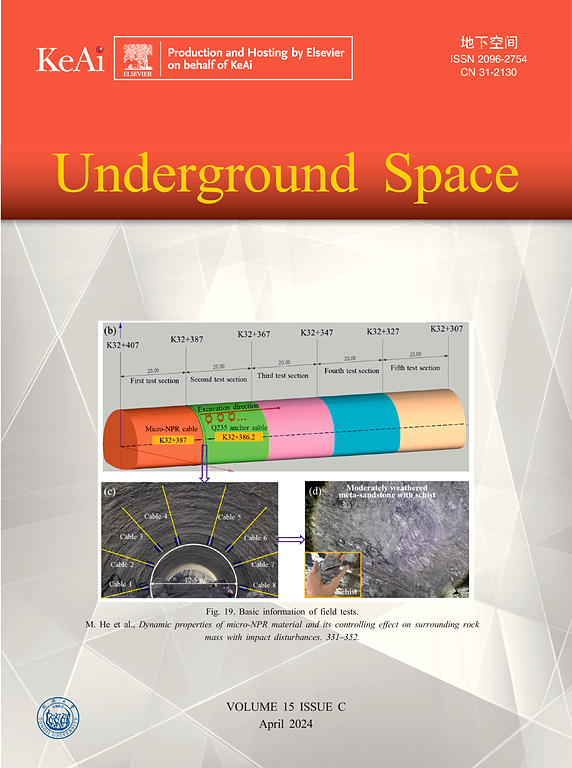基于VSM法的软土地基立井加固环基深度优化
IF 8.3
1区 工程技术
Q1 ENGINEERING, CIVIL
引用次数: 0
摘要
在人口密集、地质条件复杂的城市地区建设竖井,面临着巨大的挑战,需要创新施工技术和优化设计。本文研究了上海软土条件下,采用立井掘进机(VSM)法开挖的42.5 m深竖井的变形特性。综合数值分析模拟了VSM施工过程,分析了竖井结构内部、周围土体和邻近建筑物的变形情况,同时评价了不同加筋环底深度对施工的影响。结果显示,通过将加固环底部深度增加到最佳的16米,增强横向稳定性,最大横向轴变形显著减少30%,从28毫米减少到20毫米。受开挖阶段、桩身安装、水压和邻近荷载等因素的影响,环段和桩段的竖向变形表现出复杂的沉降和隆升机制。最佳深度为16 m,有效地缓解了隆升,优化了荷载分布,将最大沉降限制在12 mm,同时最大限度地减少了脱水引起的隆升效应。分析表明,随着挖掘距离的增加,周围建筑物的横向移动和沉降减少,突出了VSM对邻近建筑物影响最小化的潜力。本研究强调了VSM在地质复杂地区竖井工程中的适用性,为设计、减轻环境影响以及提高软土中深挖的安全性和效率提供了见解。研究结果有助于优化竖井施工,确保在具有挑战性的条件下成功实施地下基础设施。确定最佳加固环基底深度,通过减少干扰促进城市可持续发展。本研究为复杂地下工程提供了创新的方法和策略。本文章由计算机程序翻译,如有差异,请以英文原文为准。
Optimization of reinforced ring base depth for vertical shaft sinking in soft soil using VSM method
Constructing vertical shafts in densely populated urban areas with complex geological conditions poses significant challenges, necessitating innovative construction techniques and design optimization. This study investigates the deformation behavior of a 42.5 m deep shaft excavated using the vertical shaft sinking machine (VSM) method in Shanghai’s soft soil conditions comprising deep cohesive soil layers. Comprehensive numerical analysis simulated the VSM construction process, analysing deformations within the shaft structure, surrounding soil, and adjacent buildings while evaluating the influence of varying reinforced ring base depths. Results reveal a significant 30% reduction in the maximum lateral shaft deformation, from 28 to 20 mm, by increasing the reinforced ring base depth to an optimal 16 m, enhancing lateral stability. Vertical deformations exhibited complex settlement and uplift mechanisms in segmental rings and piles, influenced by factors like excavation stages, pile installation, water pressures, and adjacent loads. The optimal 16 m depth effectively mitigated uplift, and optimized load distribution, limiting the maximum settlement to 12 mm while minimizing dewatering-induced uplift effects. Analysis indicated reduced lateral movements and settlements in surrounding buildings with increasing distance from excavation, highlighting VSM’s potential for minimizing impacts on neighboring structures. This study emphasizes VSM’s suitability for shaft projects in geologically complex areas, providing insights for design, mitigating environmental impacts, and enhancing deep excavation safety and efficiency in soft soils. The findings contribute to optimizing vertical shaft construction, ensuring successful underground infrastructure execution in challenging conditions. Identifying the optimal reinforced ring base depth promotes sustainable urban development by minimizing disturbances. This research advances innovative methods and strategies for complex underground projects.
求助全文
通过发布文献求助,成功后即可免费获取论文全文。
去求助
来源期刊

Underground Space
ENGINEERING, CIVIL-
CiteScore
10.20
自引率
14.10%
发文量
71
审稿时长
63 days
期刊介绍:
Underground Space is an open access international journal without article processing charges (APC) committed to serving as a scientific forum for researchers and practitioners in the field of underground engineering. The journal welcomes manuscripts that deal with original theories, methods, technologies, and important applications throughout the life-cycle of underground projects, including planning, design, operation and maintenance, disaster prevention, and demolition. The journal is particularly interested in manuscripts related to the latest development of smart underground engineering from the perspectives of resilience, resources saving, environmental friendliness, humanity, and artificial intelligence. The manuscripts are expected to have significant innovation and potential impact in the field of underground engineering, and should have clear association with or application in underground projects.
 求助内容:
求助内容: 应助结果提醒方式:
应助结果提醒方式:


